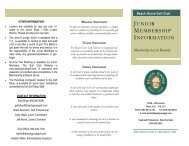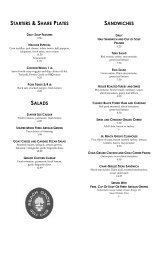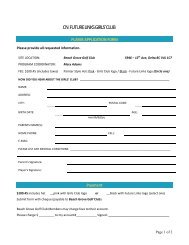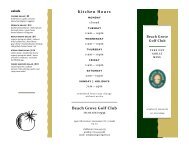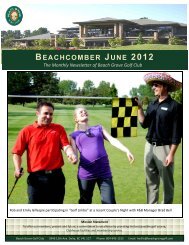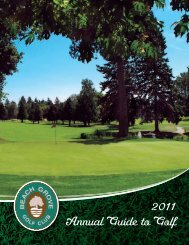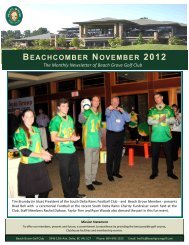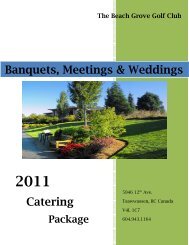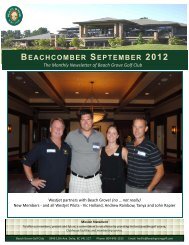USGA Green Section Turf Advisory Service Visit - Beach Grove Golf ...
USGA Green Section Turf Advisory Service Visit - Beach Grove Golf ...
USGA Green Section Turf Advisory Service Visit - Beach Grove Golf ...
Create successful ePaper yourself
Turn your PDF publications into a flip-book with our unique Google optimized e-Paper software.
<strong>Beach</strong> <strong>Grove</strong> <strong>Golf</strong> Club -7-<br />
May 4, 2005<br />
Recommendations. Specific recommendations for the green surrounds included the following:<br />
• Address collar dams using either the “Fircrest” or “Glendale” approach. The existence of<br />
collar dams can be noted on nearly every green at <strong>Beach</strong> <strong>Grove</strong> due to regular sand applications<br />
and dragging resulting in more sand placed on the collars than on the outer edge of the greens.<br />
This very common problem is noted at virtually every older golf course in the U.S., unless<br />
regular aeration occurs on the collars on the same day as the greens. Mr. Murray mentioned<br />
that this is exactly what has been done at <strong>Beach</strong> <strong>Grove</strong> for many years, however the collar dams<br />
still exist resulting in water not flowing immediately off the fronts of the greens and “reverse”<br />
contours where well hit shots can “skip” across the surface rather than react like normal shots.<br />
For this reason, it was suggested to either use the strip and resod method used at Glendale and<br />
Tacoma CC during the past two years or the slower “Fircrest” method of aeration 3-4 times<br />
yearly without topdressing and a vibratory compactor to physically move the soil lower on the<br />
collars. Both techniques are producing good results and can improve this slow change of<br />
contours at <strong>Beach</strong> <strong>Grove</strong>.<br />
• Expand the positive program on the aprons<br />
out as far as the budget will allow. One of the<br />
major problems noted on the front nine fairways<br />
is the high population of earthworms in your<br />
very healthy soil. The exact opposite was noted<br />
on the back nine where the sand based fairways<br />
are virtually clean from earthworms as they<br />
avoid the abrasiveness of the sand. While the<br />
aprons on the course are not all comprised of<br />
sand, they are literally free of earthworms, thus<br />
the obvious question is, “How can these areas be<br />
so clean and comprised of so much bentgrass” The answer is found in three key programs that<br />
have been practiced for many years that should be expanded out to 100 yards from every green,<br />
if possible. First, regular aeration and sand topdressing (especially light topdressing at the same<br />
time as the greens) adds the sand component to the surface. The second program has been the<br />
use of triplex mowers with baskets to remove the food (grass clippings) source for earthworms<br />
while greatly reducing the Poa annua seedheads deposited that compete with bentgrass.<br />
Finally, pink snow mold is a major problem on Poa annua and needs to be controlled on the<br />
aprons to assure complete coverage in these important locations. All three of these programs<br />
have led to a major improvement in turf quality that can be expanded in the same manner<br />
further away from the greens, as shown in the above photo taken on No. 18. The earthworms<br />
don’t stop at the road because of this hard surface. They stop due to the proper programs<br />
conducted by Mr. Murray over the past several years.<br />
• Create a more effective communication tool for the bunkers. There is virtually no golf<br />
course in the Pacific Northwest that does not occasionally have players complain about the<br />
“consistency” of their bunkers! These hazards require nearly as much maintenance as greens<br />
while being driven by the expectation levels of players. To assist the maintenance staff, it was<br />
suggested to create a small form for players to pinpoint exactly what portion of an individual



